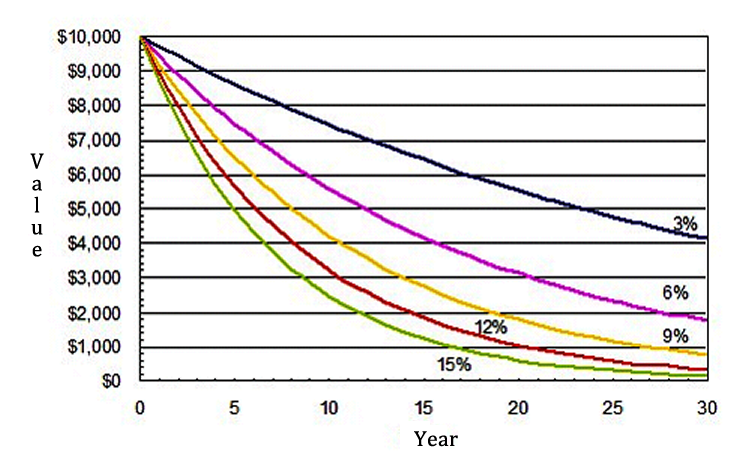| << Chapter < Page | Chapter >> Page > |
Economists have developed a tool for comparing net benefits at different points in time called discounting . Discounting converts a quantity of money received at some point in the future into a quantity that can be directly compared to money received today, controlling for the time preference described above. To do this, an analyst assumes a discount rate r , where r ranges commonly between zero and ten percent depending on the application. If we denote the net benefits t years from now as V t (in the current year, t =0), then we say the present discounted value of V t is Figure 6.4.2 shows how the present value of $10,000 declines with time, and how the rate of the decrease varies with the choice of discount rate r . If a project has costs and benefits every year for T years, then the net present value of the entire project is given by .

A particular cost or benefit is worth less in present value terms the farther into the future it accrues and the higher the value of the discount rate. These fundamental features of discounting create controversy over the use of discounting because they make projects to deal with long-term environmental problems seem unappealing. The most pressing example of such controversy swirls around analysis of climate-change policy. Climate-change mitigation policies typically incur immediate economic costs (e.g. switching from fossil fuels to more expensive forms of energy) to prevent environmental damages from climate change several decades in the future. Discounting lowers the present value of the future improved environment while leaving the present value of current costs largely unchanged.
Cost-benefit analysis is just that: analysis of the costs and benefits of a proposed policy or project. To carry out a cost-benefit analysis, one carefully specifies the change to be evaluated, measures the costs and benefits of that change for all years that will be affected by the change, finds the totals of the presented discounted values of those costs and benefits, and compares them. Some studies look at the difference between the benefits and the costs (the net present value), while others look at the ratio of benefits to costs. A “good” project is one with a net present value greater than zero and a benefit/cost ratio greater than one.
The result of a cost-benefit analysis depends on a large number of choices and assumptions. What discount rate is assumed? What is the status quo counterfactual against which the policy is evaluated? How are the physical effects of the policy being modeled? Which costs and benefits are included in the analysis—are non-use benefits left out? Good cost-benefit analyses should make all their assumptions clear and transparent. Even better practice explores whether the results of the analysis are sensitive to assumptions about things like the discount rate (a practice called sensitivity analysis ). Scandal erupted in 2000 when a whistle-blower revealed that the Army Corps of Engineers was pressuring its staff to alter assumptions to make sure a cost-benefit analysis yielded a particular result ( EDV&CBN, 2000 ). Transparency and sensitivity analysis can help to prevent such abuses.

Notification Switch
Would you like to follow the 'Sustainability: a comprehensive foundation' conversation and receive update notifications?